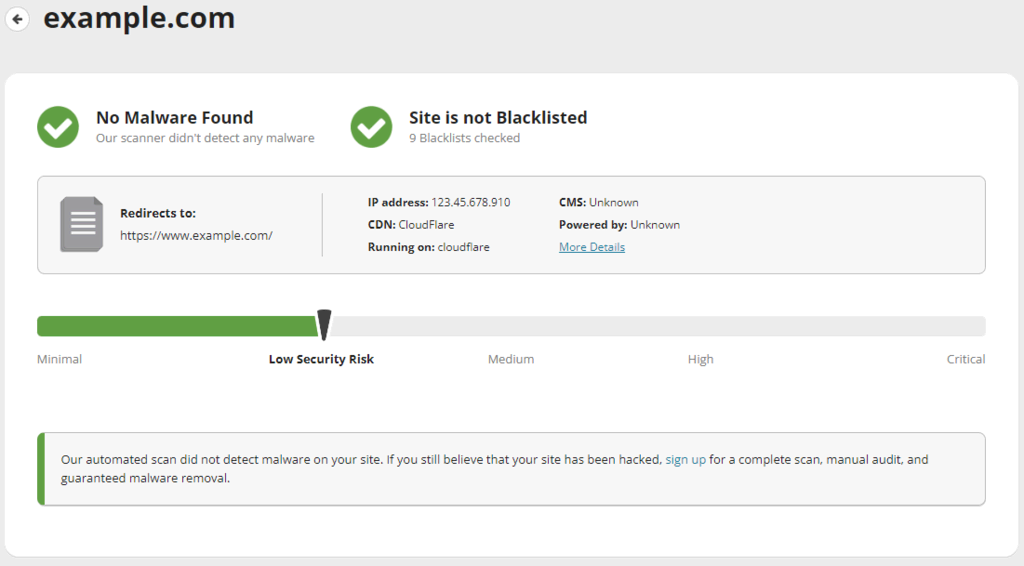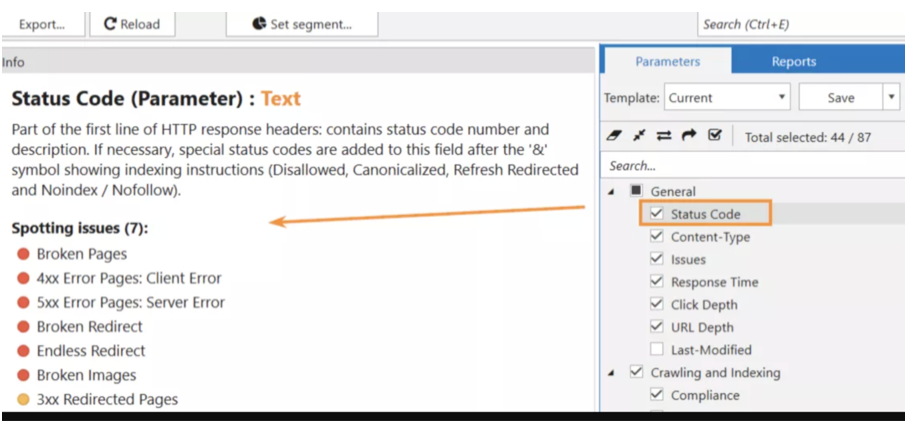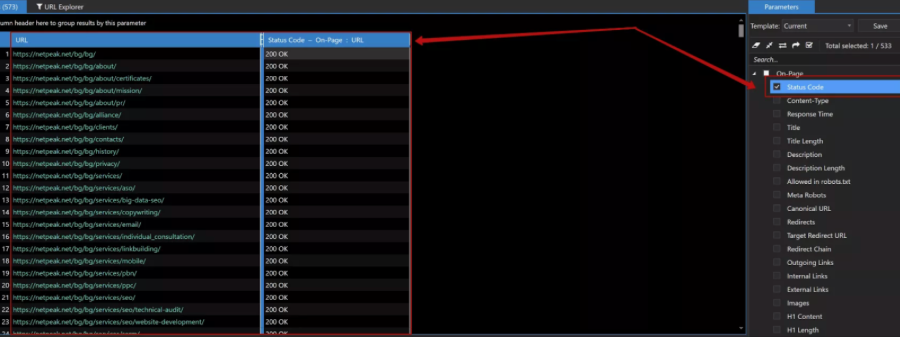How to fix the 503 error code and improve your site maintenance and SEO
Site Audit Issues.png)
Content:
- HTTP status code types
- How to Handle 503 Status Code for Effective Communication with Google
- Implementation of 503 Status Code with Retry-After Header
- Pro-tips for Effective Site Maintenance
- How To Fix The HTTP 503 With Netpeak Spider?
- Conclusion
First of all, the reasons for the 503 error code may be different, so there is no one-size-fits-all solution. However, if you spare enough time to analyze your website, you will find the core of the issue. But first, let’s start with defining 503 error code and different status code types.
HTTP status code types
Let’s start with a 503 error meaning. A 503 Service Unavailable error means that your server can’t handle the client request now. As we have already mentioned, the reasons may differ, such as server maintenance works, unexpected traffic spikes the server can’t handle, or other technical issues.
What does error 503 mean? To communicate with the browser, servers use a bunch of different status codes:
- 1xx: Information –the request is processed by the server
- 2xx: Success – the request is accepted, and the server responds with the page or resource. For example, 200 OK
- 3xx: Redirection – the page or resource has moved to a new location, and server will respond there, for example, 302 Found
- 4xx: Client error – there is an error in the browser request, for example, 403 Forbidden
- 5xx: Server error – there is an error with the server, such as 503 unavailable
The last two digits indicate the problem; for example, 301 server redirect means that the resource has moved permanently, whereas in the case of 302 error, it is temporary.
Here are the main types of HTTP code 503 messages:
- 503 Service Unavailable
- Error 503 Service Unavailable
- 503 Service Temporarily Unavailable
- HTTP Error 503
- HTTPS Error 503
- HTTP Server Error 503
- HTTP Error 503. The service is unavailable.
All they mean is that there is no operational problem with your server. However, at the moment, it can not process the request. Let’s see how to handle it.
How to Handle 503 Status Code for Effective Communication with Google
Here are the most common ways to fix 503 status code issues and prevent website downtime.
Check if there’s no server maintenance
The first thing we recommend is to check if there’s no ongoing maintenance on your server provider. To do this, you can access your server's administration settings and check for any scheduled maintenance sessions.
Check if there’s a problem with the resource usage
Check such website metrics as RAM, CPU, I/O, entry processes, and website inodes will help you identify if the server unavailability problem is caused by limited resources. You can find these metrics in your hosting user panel.
Check your faulty firewall configuration
Sometimes, a firewall - a barrier between two networks that protects your website from malware and DDoS attacks, may interpret requests from the client as server attacks and reject them. You can fix this problem by resetting your Firewall configurations in your server admin panel.
Go through your server-side logs and check your website code
Check application and server logs to see the whole log history of your website. Besides, look at the state of the hardware running your server to identify any issues that may affect its health. Also, checking your website code for any bugs affecting the server could be useful.
Restart your server
The last but not least way to get rid of http status 503 is to restart your server. Log in to your provider dashboard and run a restart command. Sometimes, there may be some lags in the server chain so that a simple refresh can help.
Implementation of 503 Status Code with Retry-After Header
The Retry-After response-header field is usually used with a return code 503 response to indicate how long the service will be unavailable to the requesting client.

The retry-after response-header has various use cases. These are the most common ones:
- It shows the expected duration of the service’s downtime when used in conjunction with a 503 http code response.
- It specifies how long to wait before making another request in conjunction with a 429 (Too Many Requests) response.
- It indicates the shortest amount of time that should pass before the user agent issues the redirected request when used in conjunction with a redirect response
It’s also important to mention that only one browser supports the Retry-HTTP Header - the Edge Browser.
Pro-tips for Effective Site Maintenance
To avoid regular 503 redirect issues with the website and server, you need to maintain the health of your website, regularly check it for any errors, and immediately troubleshoot them. Here is the checklist of the necessary things you should do to keep your website in a good state.
Perform a regular SEO analysis
Regular SEO analysis is key to the visibility of your website and its high performance in search engine results and prevents HTTP status code 503. Regularly analyzing your website will give you a fresh report on any speed, indexing, crawling, or other technical issues. Also, review your website analytics to identify any negative changes in user behavior or traffic.
Create a website maintenance schedule
The frequency of 503 server maintenance depends on your website load and the daily changes you make. If you have a lot of daily traffic, better monitor your website twice a week. Websites with less traffic can do it once a month. Also, make sure to check your website each time you make any changes in CMS or other updates.
Update Your Content
Make sure to update your website with fresh, relevant, and useful content, as it directly influences your user experience. If your website is regularly updated and your content meets the needs of your visitors, Google will rank your website higher.
Perform security checks
A website security audit will help you identify and prevent potential vulnerabilities by analyzing your files, website core, plugins, and server. You can use different security tools for this purpose. After running a security scan, you’ll get a security report, where you’ll see whether your website has malware or is blacklisted. As we have already mentioned, the 503 HTTP status code can also be caused by a false firewall.

How To Fix The HTTP 503 With Netpeak Spider?
Netpeak Spider and Netpeak Checker are both excellent tools for conducting a technical audit of your website and checking the response codes on any page.


Here are the main reports you can get with Netpeak Spider to maintain your website health and avoid 503 status code.
- Custom website scraping and data extraction
Netpeak Spider has a built-in website scraper with up to 15 conditions and four search types (contains, Regexp XPath, CSS). With the help of our website scraping tool, you can scrape contacts, markup, content, social media metrics, competitor prices, etc.
- Complex site structure check-up
See and update your website structure based on link segments and track the statistics of the URL number and its percentage.
- Reports with an SEO audit
You can get a detailed website SEO audit report in PDF and recommendations on improving your website health.
Conclusion
If you regularly perform your website maintenance, there are fewer chances to face any 503 response code issues at the worst possible time. If your visitors are satisfied with your website experience, they're likely to come back – and vice versa. Don’t let this happen. Maintain regular check-ups and fix any issues in advance with Netpeak Spider. Sign up for a free trial to test its features!



.png)
